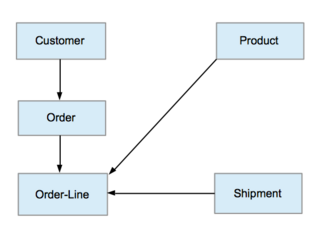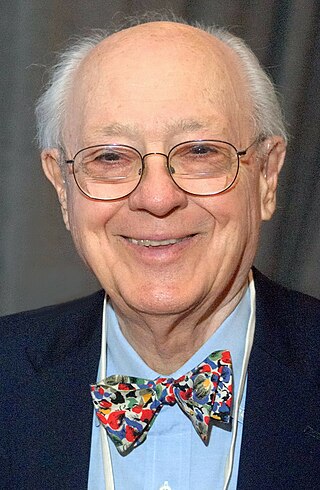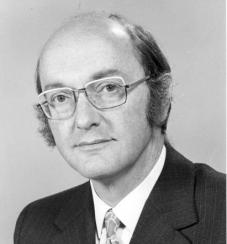
Computer science is the study of computation, information, and automation. Computer science spans theoretical disciplines to applied disciplines. Though more often considered an academic discipline, computer science is closely related to computer programming.

In computing, a database is an organized collection of data or a type of data store based on the use of a database management system (DBMS), the software that interacts with end users, applications, and the database itself to capture and analyze the data. The DBMS additionally encompasses the core facilities provided to administer the database. The sum total of the database, the DBMS and the associated applications can be referred to as a database system. Often the term "database" is also used loosely to refer to any of the DBMS, the database system or an application associated with the database.

The history of computing hardware covers the developments from early simple devices to aid calculation to modern day computers.

Butler W. Lampson, ForMemRS, is an American computer scientist best known for his contributions to the development and implementation of distributed personal computing.

In computing, the network model is a database model conceived as a flexible way of representing objects and their relationships. Its distinguishing feature is that the schema, viewed as a graph in which object types are nodes and relationship types are arcs, is not restricted to being a hierarchy or lattice.

Charles William Bachman III was an American computer scientist, who spent his entire career as an industrial researcher, developer, and manager rather than in academia. He was particularly known for his work in the early development of database management systems. His techniques of layered architecture include his namesake Bachman diagrams.
CODASYL, the Conference/Committee on Data Systems Languages, was a consortium formed in 1959 to guide the development of a standard programming language that could be used on many computers. This effort led to the development of the programming language COBOL, the CODASYL Data Model, and other technical standards.

Robert Elliot Kahn is an American electrical engineer who, along with Vint Cerf, first proposed the Transmission Control Protocol (TCP) and the Internet Protocol (IP), the fundamental communication protocols at the heart of the Internet.
Checkpointing is a technique that provides fault tolerance for computing systems. It basically consists of saving a snapshot of the application's state, so that applications can restart from that point in case of failure. This is particularly important for long running applications that are executed in failure-prone computing systems.

IDEF, initially an abbreviation of ICAM Definition and renamed in 1999 as Integration Definition, is a family of modeling languages in the field of systems and software engineering. They cover a wide range of uses from functional modeling to data, simulation, object-oriented analysis and design, and knowledge acquisition. These definition languages were developed under funding from U.S. Air Force and, although still most commonly used by them and other military and United States Department of Defense (DoD) agencies, are in the public domain.
A navigational database is a type of database in which records or objects are found primarily by following references from other objects. The term was popularized by the title of Charles Bachman's 1973 Turing Award paper, The Programmer as Navigator. This paper emphasized the fact that the new disk-based database systems allowed the programmer to choose arbitrary navigational routes following relationships from record to record, contrasting this with the constraints of earlier magnetic-tape and punched card systems where data access was strictly sequential.

Donald Watts Davies, was a Welsh computer scientist who was employed at the UK National Physical Laboratory (NPL).

The Integrated Database Management System (IDMS) is a network model (CODASYL) database management system for mainframes. It was first developed at B.F. Goodrich and later marketed by Cullinane Database Systems. Since 1989 the product has been owned by Computer Associates, who renamed it Advantage CA-IDMS and later simply to CA IDMS. In 2018 Broadcom acquired CA Technologies, renaming it back to IDMS.
Cullinet was a software company whose products included the database management system IDMS and the integrated software package Goldengate. In 1989, the company was bought by Computer Associates. Cullinet was headquartered at 400 Blue Hill Drive in Westwood, Massachusetts.

Hardware acceleration is the use of computer hardware designed to perform specific functions more efficiently when compared to software running on a general-purpose central processing unit (CPU). Any transformation of data that can be calculated in software running on a generic CPU can also be calculated in custom-made hardware, or in some mix of both.
Cincom Systems, Inc., is a privately held multinational computer technology corporation founded in 1968 by Tom Nies, Tom Richley, and Claude Bogardus.

A computer is a machine that can be programmed to carry out sequences of arithmetic or logical operations (computation) automatically. Modern digital electronic computers can perform generic sets of operations known as programs. These programs enable computers to perform a wide range of tasks. The term computer system may refer to a nominally complete computer that includes the hardware, operating system, software, and peripheral equipment needed and used for full operation; or to a group of computers that are linked and function together, such as a computer network or computer cluster.

Michael Ralph Stonebraker is a computer scientist specializing in database systems. Through a series of academic prototypes and commercial startups, Stonebraker's research and products are central to many relational databases. He is also the founder of many database companies, including Ingres Corporation, Illustra, Paradigm4, StreamBase Systems, Tamr, Vertica and VoltDB, and served as chief technical officer of Informix. For his contributions to database research, Stonebraker received the 2014 Turing Award, often described as "the Nobel Prize for computing."
Data-intensive computing is a class of parallel computing applications which use a data parallel approach to process large volumes of data typically terabytes or petabytes in size and typically referred to as big data. Computing applications that devote most of their execution time to computational requirements are deemed compute-intensive, whereas applications are deemed data-intensive require large volumes of data and devote most of their processing time to I/O and manipulation of data.
CP-6 is a discontinued computer operating system, developed by Honeywell, Inc. in 1976, which was a backward-compatible work-alike of the Xerox CP-V fully rewritten for Honeywell Level/66 hardware. CP-6 was a command line oriented system. A terminal emulator allowed use of PCs as CP-6 terminals.













